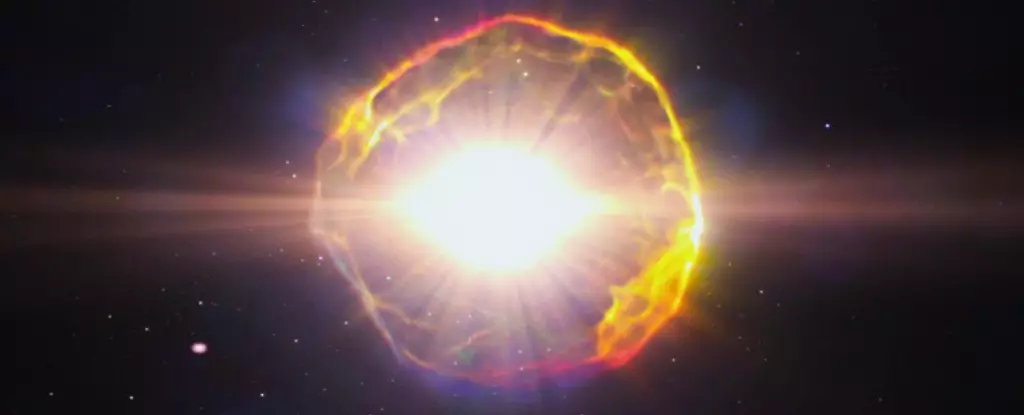The relationship between cosmic phenomena and the delicate balance of life on Earth is a captivating area of scientific inquiry. Recent findings suggest that massive stellar explosions, specifically supernovae, may have played a formidable role in shaping the history of life on our planet. An exploration led by astrophysicist Alexis Quintana from the University of Alicante has highlighted a compelling correlation between supernova occurrences in our galaxy and two of the most significant mass extinction events: the Late Ordovician and the Late Devonian extinctions. These calamitous events, known as part of the Earth’s “Big Five,” mark epochs of tremendous biodiversity loss, igniting questions about the nature of these interactions and their implications for understanding our planet’s past.
Understanding how pivotal changes in the cosmos could lead to widespread extinction events is essential for discernment of Earth’s biological resilience. The emergence of supernova diagnostics offers an intriguing lens through which astronomers and earth scientists can collaborate to unearth the enigmatic chapters of life’s tumultuous history. Notably, the excitement surrounding these astronomical discoveries demands rigorous attention, as it not only extends our understanding of cosmic forces but also deepens our comprehension of Earth’s ecosystem dynamics.
The Mechanics of Supernovae and their Consequences
Supernovae are unearthed as cataclysmic phenomena resulting from the explosive deaths of massive stars. These stellar giants, often exceeding eight times the mass of our Sun, undergo a relatively short lifespan, burning brilliantly for millions of years before succumbing to gravitational collapse and resultant explosion. The aftermath is staggering—a cosmic strategy that ejects stellar materials at incredible velocities into the surrounding galaxy. An explosion closer to Earth could unleash intense radiation capable of depleting the protective ozone layer—a malignant scenario for terrestrial ecology, as the influx of harmful ultraviolet (UV) radiation severely endangers life.
Historical extinction events, notably the Late Ordovician extinction around 445 million years ago and the Late Devonian extinction approximately 372 million years ago, featured dramatic biodiversity loss—wipeouts occurring on an unprecedented scale. The speculation surrounding the ozone layer’s depletion during these epochs lends credence to the theory that nearby supernovae could be linked to these catastrophes, fundamentally changing the course of Earth’s biological evolution.
Astrophysical Insights: Cataloging Stellar Giants
Quintana and colleagues employed meticulous analysis to bridge the gap between supernova frequency and Earth’s extinction events. By conducting a census of massive OB-type stars within a kilometer radius of the Sun—a domain of roughly 3,260 light-years—they could establish birth and death rates of these high-energy stars. Their findings revealed the presence of 24,706 such OB stars, leading to an estimated supernova occurrence of approximately 15 to 30 per million years across the Milky Way.
Delving deeper, the team focused on the rate of OB supernovae specifically within a 20-parsec radius, translating to around 65 light-years from our Solar System. This narrowed focus delivered a startling discovery: a supernova occurrence rate of roughly 2.5 events per billion years in proximity to Earth, a figure that intriguingly aligns with the timelines of the Late Ordovician and Late Devonian extinctions.
A Cosmic Perspective on Existence
Fortunately, present circumstances offer a semblance of reassurance. Currently, no nearby stars are on the precipice of a supernova explosion that could jeopardize life on Earth. Red giants like Antares and Betelgeuse are aging and theoretically should explode in the distant future—but at a cosmic scale, they remain far enough away to alleviate immediate concerns. Nevertheless, lingering threats persist, including rogue asteroids and volcanic eruptions, two formidable natural events that underscore the planet’s susceptibility to existential predicaments.
This duality reflects the delicate balance of Earth’s existence—an interplay between the celestial and terrestrial, exhibiting that while we may stand spared from imminent supernova terrors, we are still vulnerable to the whims of nature. Such realizations arouse philosophical musings about our place within the cosmos and the myriad possibilities that shape our survival.
The Quest for Understanding
As humanity deepens its understanding of cosmic events and their terrestrial ramifications, it fuels a quest for knowledge that transcends scientific disciplines. This intricate dance between stars and our ecological systems inspires inquiry not only among astrophysicists but also biologists, ecologists, and philosophers alike. It beckons us to gaze skyward, pondering the implications of the universe on our continuation as a species. As researchers diligently uncover the cosmic rhythms that link our fate to the heavens, we remain in awe of the robust tapestry that is life—woven through both stellar fireworks and terrestrial perseverance.

